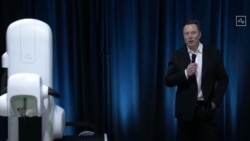American billionaire Elon Musk has demonstrated a technology designed to use a computer chip inside the head to control the brain.
During a video demonstration on Friday, Musk provided details about the system, called Neuralink. In addition to leading the Neuralink startup, Musk also heads electric carmaker Tesla and U.S. space company SpaceX.
Musk says he hopes the technology can be used to treat neural disorders and help spinal injury victims regain body movement. Musk also believes the system could be used in the future to improve intelligence to help humans keep up with supercomputers and artificial intelligence (AI) technology.
During the demonstration, Musk showed off a model of the Neuralink device. It is about 23 millimeters wide. It is designed to be implanted into a person’s skull. Small wires would connect the device directly to the brain.
The Neuralink system is currently being tested in pigs, with plans to seek government approval for human testing sometime in the future.
Neuralink’s head surgeon, Dr. Matthew MacDougall, said the company’s first human tests would involve a small number of people. The tests would be aimed at treating individuals suffering from paralysis – a condition that makes someone unable to move or feel all or part of their body.
During the demonstration, Musk showed off a pig named Gertrude. He explained that Gertrude had a Neuralink implant inside its head. The device is meant to record nerve activity in the pig’s nose and mouth.
Musk said the company had three pigs, each with two implants. He described the animals as “healthy, happy and indistinguishable from a normal pig.” Musk said the company was able to predict with “high accuracy” a pig’s leg movement on a running machine using data from the implant.
Musk used the event to invite engineers and other experts to join the company in developing the technology. He also urged people to develop their own devices and bring them to Neuralink. “You don’t need to have brain experience,” Musk noted. Those skills can be learned on the job, he said.
Linking a brain directly to electronics is not new. Doctors implant electrodes in brains to deliver signals to treat conditions such as Parkinson’s disease, epilepsy and pain. In experiments, implanted sensors have let paralyzed people use brain signals to operate computers and move robotic arms. In 2016, researchers reported that a man regained some movement in his own hand with a brain implant.
Musk’s Neuralink hopes to one day offer operations to improve brain performance, the Wall Street Journal reported when the company launched.
Musk noted that Neuralink first wants to use the device on people with severe spinal cord injuries to help them talk and move using their brain waves. He said he is hopeful that, in the long term, those people could regain “full-body motion.”
Members of the Neuralink team said they also would like to see the technology permitting the uploading of memories for later use. “Yes, I think in the future you will be able to save and replay memories," Musk said.
Neuroscientists not linked to the company said the presentation suggested Neuralink had made great progress with the technology. However, they warned that many more studies will be needed to test the long-term success of such devices.
I’m Bryan Lynn.
The Associated Press, Reuters and Agence France-Presse reported on this story. Bryan Lynn adapted the reports for VOA Learning English. Ashley Thompson was the editor.
We want to hear from you. Write to us in the Comments section, and visit our Facebook page.
_______________________________________________________________
Words in This Story
chip – n. an electronic device that contains many circuits used in computers
artificial intelligence – n. the power of a machine to copy intelligent human behavior
implant – v. to place something into someone's body in a medical operation
surgeon – n. a doctor who performs medical operations
indistinguishable – adj. impossible to see or hear as different or separate
accuracy – n. how correct or exact something is










